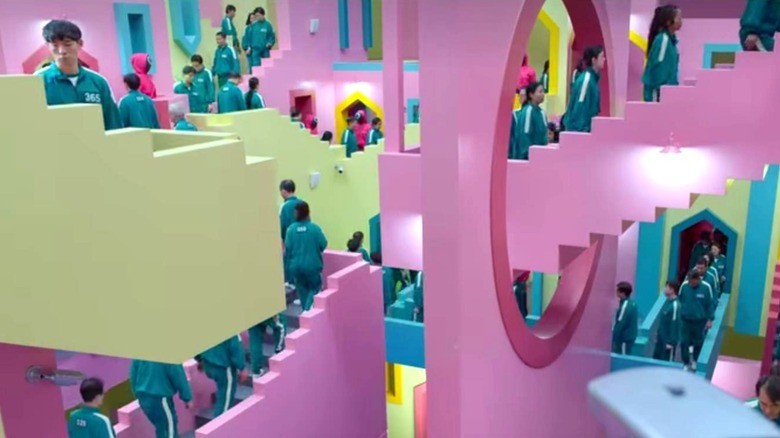In Squid Game, Netflix’s most popular show ever, the setting is co-protagonist of the narration: between the dark atmospheres of a Panopticon or a Piranesian prison and the sugary suggestions of a stereotyped kindergarten, the spaces are designed - and deformed - to subtly and insidiously affect the psychology of the characters. The constant theme is the discrepancy between the space evoked - often linked to childhood memories - and the violence of the activities that take place there: the loss of the aura of innocence from childhood to the adult world, with its exacerbated perversions.
The dormitory, the staircase and the waiting room
The dormitory, for example, is striking, where bunk beds are piled up around the central space: the suggestion is that of a place where people, under the blows of massification, lose their identity and are reduced to objects piled up on the shelves of a warehouse.

Another disturbing environment is the staircase that participants cross to access the arenas: with its labyrinthine conformation inspired by Escher's lithography, it provokes a sense of disorientation despite the mellifluous pastel colours that recall Bofill's Muralla Roja.

In contrast to the colour explosion elsewhere, the waiting room is dazzlingly white: with its stark minimalism, curved walls and dreamlike atmosphere, it is designed to create a sense of eerie anticipation of an unclear development.
Combat arenas
Then there are the combat arenas where bewilderment reigns as opposed to the pacifying evocation of emotions that belong to a perhaps happy age of purity and candour. The first arena is a mock bucolic space accessed by simplified architecture and lined with blue sky wings. A perturbing element is the maxi doll with cameras instead of eyes that plays the intimidating role of a Big Brother: the oversized toy perversely inverts the parts, by making adults pathetic toys in the hands of a superior force.

In the playground where Game 2 takes place, counterfeit atmospheres with cartoonish clouds and sunshine, and slides and swings totally out of scale subtend, as in the previous arena, the nullity of the individual conceived as a pawn.

In the arena for Game 3, gigantic platforms suspended on trestles in a bright yellow contrasting with the dark surrounding space are the support surface on which the teams compete in a tug-of-war: the macroscopic structures once again evoke the annihilation of the person crushed by the weight of the power that governs him.

The field for Game 4 is a pseudo-Korean village made up of alleys and houses with a red background that provides the setting for a deadly game of marbles in stark contrast to the participants' memories of traditionally cherished places.
Lastly, Game 5 takes place on a glass bridge with the pitfall of untempered sheets which, if stepped on, inevitably plunge the unfortunate victim into darkness: a walk that has the feel of a grotesque performance, illuminated by flashing lights that evoke a circus atmosphere between ridicule of the performer and cheap spectacle.

A fierce critique of the contemporary world of which the series is a metaphor.

The Trafic parquet collection: a new language for spaces
Designers Marc and Paola Sadler draw on now-extinct urban scenarios to create an original and versatile product for Listone Giordano.

















